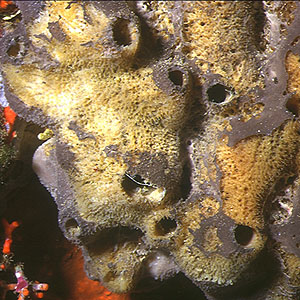Sponge
(Euspongia officinalis)

Characteristics
Sponges are
perforated by miniscule canals trough which seawater is pomped
by the action of thousands of flagellae. Food particles are
captured by specialized feeding cells. Most sponges have skeletons
composed of tiny spicules made of calcium carbonate or silica.
Natural
resource value
Sponges are rich sources of chemicals used
in the pharmacological industries.
Influence
of man
The sponge Euspongia
officinalis was fished in the Mediterranean Sea since
ancient times, because after it had been dried, it was used
for washing and bathing. Synthetic sponges are now more used.
Sponges can now be affected by sewage pollution and damaged by towed fishing
gear.

